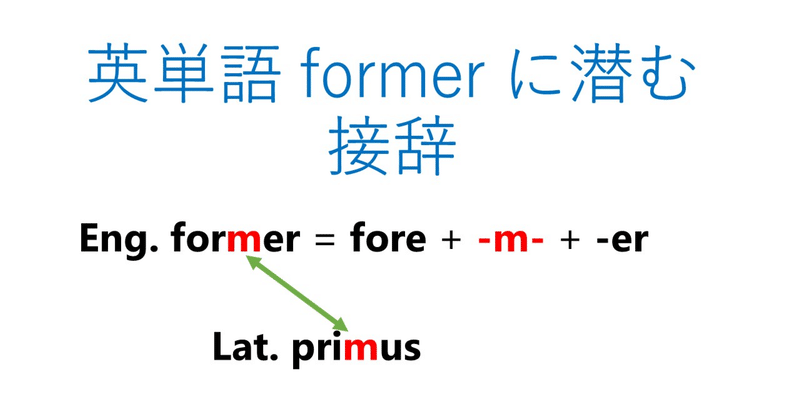
おもしろい英単語② ~ former に潜む接辞~
暫くお休みしていました。久し振りの更新です!今回は英単語 former について。この単語、意味を知らない人はいないと思いますが、例によって語源的な部分の面白さを説明していきます。
なお、以下の記事も良ければ読んでみて下さい。(内容は独立しています)
1. OED における記述
Oxford English Dictionary [1] における記述を紹介します。
1.1. former
First recorded in the 12th century; a comparative formed on the analogy of formest, foremost adj.
つまり、 foremost から類推で作られた比較級ということですね。それではその foremost はどうなのでしょう。
Old English formest , fyrmest : = Gothic frumist-s , < Old Germanic *formo- (forme adj.1) with additional superlative suffix (see -est suffix).
ゲルマン語 *formo- (英語 † forme) に最上級接尾辞を付けた古英語の formest に遡れることが分かりました!それでは更にその † forme を見ていきましょう。
[註] 記号 † は語が廃用であることを示します。
Old English forma < Old Germanic *formon-, a superlative (with -m- suffix as in Latin prīmus) from the root of fore adv.
実は fore (の語根)に最上級接辞 -m- を付けた形なんです! formest には二重に最上級接辞がついていることになります。さらにさらにこれはラテン語の prīmus の -m- と語源的に対応しているんですね。
1.2. -most
foremost が出てきたので接尾辞 -most についても見ておきましょう。
Cognate with Gothic -umist-, a superlative suffix found in six adjectives (e.g. auhumists highest, cognate with Old English ȳmest) < the Germanic base of the superlative suffix in -m- attested in Old English forma first, hindema last (< the same Indo-European base as the suffix attested in classical Latin prīmus prime adj.) + the Germanic base of -est suffix.
上でも見たように、二つの最上級接辞の合成 -m- + -est と解釈できます。
以下は古英語の接尾辞 -mest についての記述です。
Those Old English superlatives in -mest which either descend from Germanic, or are extensions with -est of Germanic superlatives in -m-, are formed not on adjectives but on prepositional or demonstrative stems; examples are æftemest (see aftermost adj.), formest (also fyrmest) foremost adj., inmest inmost adj., niðemest nethemest adj., ufemest (more commonly attested in form yfemest) umest adj.), ūtmest (more commonly attested in form ȳtmest) utmost adj. and n., ȳmest highest; the only instance (among the words belonging to this primary group) of formation on an adjectival stem is midmest midmost adj. On the analogy of these older words, the suffix -mest was in Old English used to form superlative adjectives (chiefly from adverbial stems) of local and temporal signification, as lætmest latemost adj., sīðemest latest, ēastemest eastmost adj., westmest (also westema) westmost adj., norðmest northmost adj., sūðmest southmost adj.
つまり、本来的には前置詞や指示詞の語幹に限って接辞していたが、古英語では一部の形容詞(場所や時間を表わすもの)にも接辞するようになったということですね。
2. ゴート語における-𐌿𐌼𐌰 (-uma)
さてゲルマン語といえばゴート語ですよね(?)
ゴート語では -𐌿𐌼𐌰 (-uma) で終わる一群の形容詞が見られます。ただし、これらの中には最上級としての意味が弱まり、位置を表わしたり比較級の意味合いになっているものも多いです。
具体的には以下の六つが挙げられます。なお弱変化です。
2.1. 𐌰𐌿𐌷𐌿𐌼𐌰 (auhuma) <より高い>
ni waiht bi haifstai aiþþau lausai hauheinai, ak in allai hauneinai gahugdais anþar anþarana munands sis auhuman;
2.2. 𐌰𐍆𐍄𐌿𐌼𐌰 (aftuma) <最後の>
2.3. 𐍆𐍂𐌿𐌼𐌰 (fruma) <前の>
aþþan managai wairþand frumans aftumans, jah aftumans frumans
一つの節に4つも出てきています!オトク!
2.4. 𐌹𐍆𐍄𐌿𐌼𐌰 (iftuma) <後続する>
iftumin daga で <明日に> の意味でのみ登場します。
iftumin þan daga, saei ist afar paraskaiwein, gaqemun auhumistans gudjans jah Fareisaieis du Peilatau
なお、例文中の auhumistans は 2.1. の auhuma に -ists がついた最上級の形ですね。
2.5. 𐌷𐌻𐌴𐌹𐌳𐌿𐌼𐌰 (hleiduma) <左の>
iþ þuk taujandan armaion ni witi hleidumei þeina, hva taujiþ taihswo þeina,
2.6. 𐌹𐌽𐌽𐌿𐌼𐌰 (innuma) <内側の>
gawizneigs im auk witoda gudis bi þamma innumin mann;
なお、訳など詳しくは [2] § 139. や [3] などを参照してください。
3. 他の印欧語における対応物
ラテン語では典型的には形容詞の最上級は -issimus で作られます。また、補充法によるもの(optimus, minimus など)、前置詞や副詞の語幹から作られるもの(prīmus, summus など) もあります。これらに共通している -m- の部分が今回の former の -m- と同じく印欧祖語の *-(t)m̥mo- に由来しているわけです。もちろん -issimus などは他の接辞 *-is-と組み合わさって出てきているので完全に同じ訳ではないですが。そして、サンスクリットの最上級接尾辞 -tama もこれと同根です。
例によって詳しくは [4] を参照してください。
注意と言い訳
本来ゲルマン語のみならず、他の様々な印欧語を比較して、再構を行う(例えば *-(t)m̥mo- が absolutive であることを示す接辞だと仮定)と、former の語形を尤もらしく(言いくるめるという意味でなく、「尤度」が高いということ)解析できるというのが本来の方向性ではあります。ただ、そのようなことは当然前提として共有されているという共通認識の元で天下り的に説明している形になりますからご注意ください。
また、前にも触れた気がしますが、私は専門的に言語を勉強しているわけではなく趣味で記事を書いているので色々と不正確なところがあると思います。これも今更ですがご注意ください。
まとめ
former という単語は for(e)- + -m- + -er と解釈できて -m- はゲルマン語外の印欧語にも現われる最上級接辞(例:ラテン語 prīmus)の痕跡を残します。これらはゲルマン語では早くに最上級としての意味を失ったと考えられ、さらに(現代のゲルマン語で頻用の)最上級接辞 -est を付けることで -most (OE -mest, Gothic -umists)という接辞ができています。(なお現代英語の -most の語形は独立した単語 most の影響を受けています。)
久し振りの更新でしたが、書く中で色々勉強になりました。またちょこちょこ更新していきたいなと思っておりますので、宜しければ読んでやってください。宜しくお願いします。
参考文献
[1] Oxford English Dictionary (https://www.oed.com/)
[2] Braune, Ebbinghaus, Gotische Grammatik (17. Auflage)
[3] Wulfila Project (http://www.wulfila.be/gothic/browse/)
[4] Sihler, New Comparative Grammar of Greek and Latin
この記事が気に入ったらサポートをしてみませんか?
